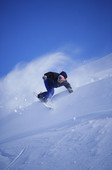
MONDAY, Aug. 23 (HealthDay News) — What activity involves careening down hills at high speeds without protective gear or brakes?
Maybe you’re stumped because the most of the country is sweltering in one of the hottest summers in years, but the answer is sledding, and new research shows that the winter pastime accounts for some 20,000 injuries each year.
“It’s probably not something that’s on everyone’s minds right now,” said senior study author Lara McKenzie, a principal investigator at the Center for Injury Research and Policy at Nationwide Children’s Hospital in Columbus, Ohio. “But 20,000 injuries a year for a recreational pastime you can only do when it’s snowing is a lot.”
Boys, especially those aged 10 to 14, were most prone to accidents, accounting for nearly 60 percent of those injured.
“Boys are more likely than girls to be injured in almost everything,” McKenzie said. “That’s a pretty standard finding.”
Using data from the U.S. Consumer Products Safety Commission’s National Electronic Injury Surveillance System, researchers found that nearly 230,000 children and teens were treated in U.S. hospital emergency departments for sledding-related injuries between 1997 and 2007.
According to the study, published in the September issue of Pediatrics, fractures were the most common injury (26 percent), followed by cuts and bruises (25 percent), strains and sprains (16 percent) and traumatic brain injuries (9 percent). Overall, the head was the most commonly injured body part, accounting for 34 percent of injuries requiring emergency department care.
Head injuries are also the most serious, noted Dr. Michelle Macy, a pediatric emergency medicine physician at University of Michigan who sees kids injured from sledding every winter.
“Any time a kid’s brain is injured, it’s a particular concern,” Macy said. “Broken bones will heal, but the consequences of a head injury can be lifelong.”
Collisions with trees, utility polls, fellow sledders and other obstacles caused about half of the injuries, according to the study. Collisions were the most likely to result in a head injury. Other causes of injuries were falls, flips and leaps off the sled, toboggans, snow tubes or snow disks.
Going to an official sledding zone doesn’t seem to offer much protection. More than half of injuries occurred at a sports or recreation area, while about one third occurred on private property.
With some ski resorts are now requiring minors to wear helmets, and proposals in several state legislatures pending at various stages, sledders may also want to consider donning protective gear, McKenzie said, citing one report found that wearing helmets during skiing reduced head injuries in children under age 15 by 58 percent.
When it comes time to dig out the ear muffs and mittens, at the very least, parents should keep tabs on where their kids are sledding and make sure the hill has a clear run out for the sled to glide to a stop.
“The fact that 10- to 14-year-olds, particularly the boys, are more to prone to injuries speaks to the risk taking that goes along with those ages,” Macy said. “If they can’t be there when their children are making choices about sledding, parents need to talk to their children about the environment they’re sledding in.”
Other safety tips include:
- Stay away from streets: Kids sledding on streets or highway were more likely than others to injure their head, according to the study.
- Never use a motorized vehicle to pull a sled: Nearly 6,000 kids were injured on sleds while being pulled by cars, trucks, ATVs, tractors, dirt bikes, snowmobiles and lawnmowers. (Yes, people actually do that.)
More information
The Nemours Foundation has more on winter sports safety.

